Introduction
The physical examination of persons with injuries that have been self-inflicted deliberately is part of the routine work in clinical forensic medicine. The recognition of self-harm is of criminalistic importance when differentiating between assaults, accidents, suicidal acts and other kinds of self-destructive behavior; the main categories are listed in Table 1. In cases of
Table 1 Main categories of self-induced bodily harm
1. Simulation of a criminal offense:
(a) False rape allegation
(b) Feigned robbery or alleged attack for other fabricated reasons
2. Self-mutilation for the purpose of insurance fraud
3. Voluntary self-mutilation and/or malingering among soldiers and prisoners
4. Dermal artifacts, self-mutilation and malingering in patients with personality disorders
5. Suicidal gestures, (attempted) suicide
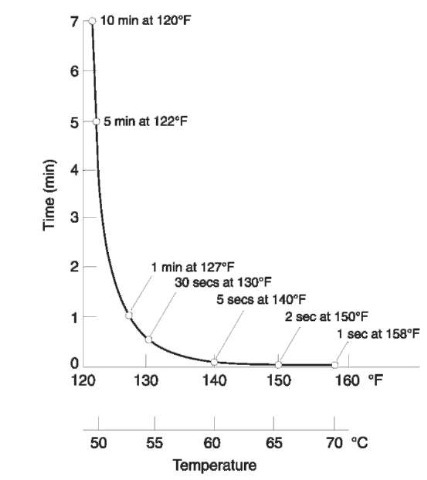
Figure 22 The factors associated with thermal injury are the temperature of the of fending medium and the duration of contact.
Conclusion
Familiarity with pattern injuries will assist physicians, nurses and law enforcement investigators with the recognition of inflicted injuries in victims of child abuse and domestic violence. The ability to differentiate between fact and fiction will benefit the criminal justice system in its effort to protect the innocent and prosecute the guilty.
Simulation of Criminal Offenses
This group comprises self-inflicted injuries of individuals who claim to have been the victim of an assault. The bodily damage, therefore, is used as alleged proof of a fictitious offense. The dramatic story told by the informant is often in obvious contrast to a uniform wound pattern (Fig. 1) and a poor severity of the injuries so that the whole picture does not suggest a real struggle with the dynamics of a fight.
According to the literature, up to 20% of the sexual offenses reported to the police are fictitious. In false rape allegations the informants frequently injure themselves in order to give support to their story (Fig. 2). Women and girls who falsely claim to have been raped often live in a problematic situation or in conflict with their partners. The primary intention of the alleged victims is mostly to derive attention, or care and affection, but there are also some informants who accuse a definite person of having raped them for motives of hate or revenge.
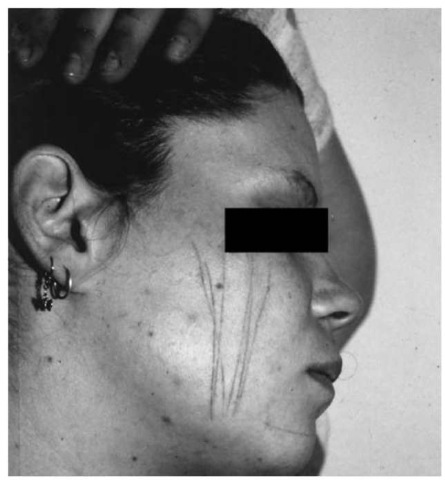
Figure 1 Group of mostly parallel skin lesions inflicted on the right cheek with nail scissors (23-year-old woman, who falsely claimed to have been the victim of a sexual assault; actually she wanted to arouse the attention of her unfaithful husband).

Figure 2 Self-inflicted injuries from a serrated kitchen knife on the lower abdomen of a young woman. She reported her ex-lover to the police in revenge for having been left and falsely claimed that he had raped her. The cuts are equally superficial and do not penetrate the skin in spite of their considerable length and the curved body surface.
Usually the self-inflicted injuries are caused with the help of pointed and/or cutting tools such as knives, razor blades, nail-scissors, and broken glass. The resulting wounds are of a trivial nature, mostly consisting of superficial cuts or linear abrasions. The characteristics of a ‘classical’ injury pattern are listed in Table 2. In typical cases there is a multitude of equally shallow lesions which are strikingly uniform in shape, often orientated in the same direction or in a criss-cross manner. The cuts avoid especially sensitive areas like the eyes, lips, nipples, and genitals. They are mainly located on the frontal aspect of the trunk, on the face, the neck, the arms and hands, and sometimes on the lower limbs. Nevertheless, self-inflicted injuries may also be found on the back of the body, as far as it is accessible for the alleged victim’s hand, or if the injuries have been caused with the assistance of another person. Often the relevant garments are either undamaged or the damage does not correspond to the skin lesions.
Table 2 Typical features of self-inflicted injuries fabricated to simulate a criminal offence
1. Infliction either by sharp/pointed instruments or by fingernails
2. Equally shallow, nonpenetratingcuts or fingernail abrasions (sometimes each of considerable length)
3. Multitude of individual lesions
4. Uniform shape, linear or slightly curved course of the lesions
5. Grouped and/or parallel and/or criss-cross arrangement
6. Symmetry or preference of the nondominant side of the body (usually the left)
7. Location in easily reachable body regions
8. Omission of especially sensitive body regions
9. No damage of the clothes or inconsistent damage
10. Lack of defense injuries
11. Additional presence of scars from former self-injurious behavior
Some women who claim a fictitious sexual assault inflict blunt skin injuries on themselves: for instance linear excoriations produced by scratching with the person’s own fingernails or by rubbing the skin against a rough surface. In rare cases, atypical findings such as contusions or singular cuts have been observed. As there are a few clinical reports on self-cutting after rape, the forensic expert has to be aware of uncommon self-destructive behavior, even in real victims with a post-traumatic stress disorder.
Apart from false rape allegations, there are some other categories of fictitious criminal offenses. Thus, an assault may be simulated and made credible by self-inflicted injuries in order to divert attention from the person’s own theft or embezzlement. The authors have also seen several male ‘victims’ who claimed to have been stabbed or cut by perpetrators because they wanted to arouse compassion and regain the affection of their wife or girlfriend (Fig. 3). In the last ten years an increasing number of informants cut swastikas, or other nazi symbols or words into their skin thus trying to gain sympathy as pretended victims of right-wing violence; if such incidents are covered in the media, they may be followed by an ‘endemic’ series of copycat acts.
Another possible reason for claiming a feigned assault is dissimulation of an attempted, but not completed suicide (e.g. in cases of nonfatal wrist-cutting). Injuries from autoerotic manipulation may also be concealed by concocting a story of criminal victimization. False allegation of kidnapping in combination with self-injury has been made by young girls and boys in order to excuse absence without leave. From the criminalistic point of view it has to be considered that perpetrators may inflict injuries on themselves in order to represent a homicide as permitted self-defense.
Self-mutilation for the Purpose of Insurance Fraud
In this category of self-destructive behavior, an accident is simulated in a fraudulent attempt to obtain compensation from an insurance company. Usually the deliberate self-inflicted damage results in mutilation, i.e. a substantial loss of a peripheral part of the body (mostly a finger or a hand). The instruments used for mutilation comprise sharp-edged tools such as axes, hatchets, meat cleavers and cutting machines, various kinds of motorized saws and, less frequently, blunt objects such as presses or conveyor belts.
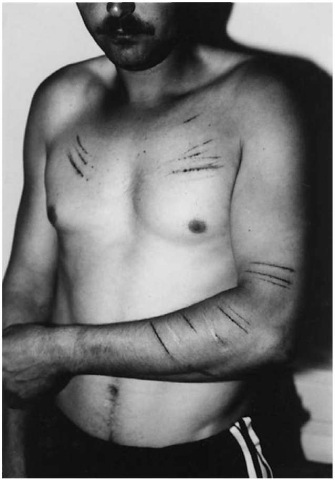
Figure 3 A 29-year-old right-handed man who inflicted cuts on his chest and left arm in order to gain the sympathy of his wife who had engaged in an extramarital affair with a lover. Note the symmetric arrangement of the chest wounds, their parallelism and uniformity. The whitish scars on the left forearm are due to former self-injurious episodes.
Voluntarily inflicted injuries from axe blows are mostly claimed to have been caused by a misplaced stroke of the axe when chopping wood. In typical cases, the thumb or index finger is cut off completely in a right angle to its axis resulting in an isolated proximal finger amputation. In contrast, an unintentional severence of the index finger is usually characterized by accompanying injuries to the adjoining fingers. In authentic accidents, the amputation is often a distal and incomplete one, taking its course in an oblique angle to the finger’s axis. The same is true for accidents with power saws or milling machines (Fig. 4).
It has been justly stressed that in finger injuries from heavy axe blows a complete amputation is to be expected only if the severed finger was lying on a solid base serving as a support. A proximal and complete amputation of the index finger without concomitant injuries of the neighboring fingers suggests a so-called ‘execution position’, which is extremely suspect of intentional self-mutilation (Fig. 5). In the last few years a considerable number of physicians – the majority being males over 40 years of age who worked in the surgical field – have been convicted of defrauding insurance companies by deliberately cutting off a finger, mostly the index finger of the nondominant left hand. Some reports have been published on cases in which members of medical professions applied a local anesthetic before injuring or mutilating themselves.
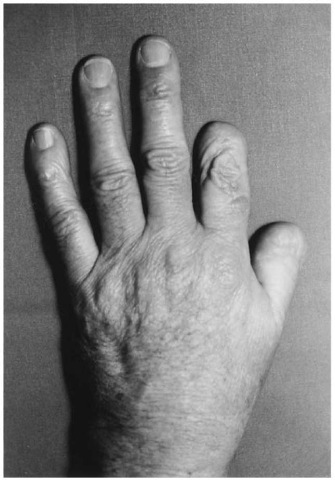
Figure 4 Left hand of a carpenter who injured himself accidentally when working with a milling machine. Note the oblique severance of the thumb and index finger. The distal phalanx of the middle finger was incompletely amputated and could be sewed on.
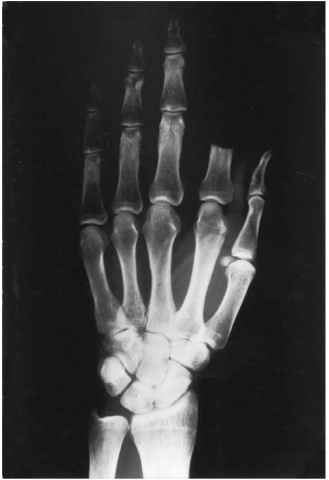
Figure 5 Self-mutilation for the purpose of insurance fraud. Radiograph of the left hand exhibiting a complete proximal amputation of the index finger at a right angle to its axis and without any injury to the adjoining fingers, allegedly caused by a misplaced stroke of the axe when chopping wood.
The proof of intentional self-infliction in cases of mutilation has been said to be one of the most difficult tasks in clinical forensic medicine. Apart from the medical aspects, some circumstantial indications may point to a possibly attempted insurance fraud:an insurance policy for inadequately high amounts taken out shortly before the injury occurs, a multiplicity of private accident insurance contracts, serious indebtedness of the policy holder, the absence of any witness, an inexplicable disappearance of the amputate, immediate tidying up of the scene, and removal of the biological traces. The presence of ‘tentative cuts’ adjacent to the amputation cut can be a positive morphological indication of deliberate self-infliction. It is recommended that the expert’s investigation should first focus on the medical findings concerning the injury (photographs, surgical report, radiographs, physical examination) and on the course of the alleged accident as described and demonstrated by the mutilated victim. In addition, the external circumstances at the scene, the mechanical properties of the causative tool, the distribution of bloodstains and other available pieces of evidence must be taken into consideration. Some experts have also carried out simulating experiments to reconstruct the alleged accident mechanism, which then turned out to be or not to be consistent with the injury in question.
Voluntary Self-mutilation and/or Malingering Among Prisoners and Soldiers
Auto aggressive behavior is a well-known problem in police custody and penal institutions. There may be different reasons for a prisoner to inflict injuries on himself: false allegations of having been physically maltreated by the police, the guard, or other inmates; the wish to be transferred to a hospital with less severe surveillance and increased chances of escape; as a correlate of a prisoner’s low tolerance to stress. Common methods of self-harm under detention are cutting oneself with sharp instruments (for instance a piece of glass, a razor blade, or a sheet iron), swallowing foreign bodies, and certain forms of malingering (voluntary provocation, aggravation, and protraction of disease by artificial means). Self-damage in prison covers a wide continuum ranging from amateurish tattooing and infliction of other skin lesions to life-threatening suicide attempts.
During war and sometimes even in peace time soldiers may fabricate ‘accidental’ injuries in order to avoid duty on the frontline or in the armed forces generally. The deliberately induced damage is intended to make the soldier unfit for military service (for example because of traumatic amputation by shooting or cutting off fingers). Another kind of evading service aims at the pretence of sickness. By feigning a medical or psychiatric illness the malingerer tries to get hospitalized or dismissed. Malingering comprises both the simulation of a nonexisting illness and the exaggeration/prolongation of an existing disease.
Artifacts in Patients with Psychic Disturbances or Mental Diseases
In neurotic patients, the main target of bodily harm is the skin which may exhibit a great variety of lesions from scratching, pinching, squeezing, rubbing, and biting. The injuries are typically produced by the person’s own fingernails, pointed/edged instruments, or rough surfaces. If the skin damage extends to the corium it will heal with scarring, and occasionally, pigmentation. The majority of neurotic excoriations are irregular in shape and located in easily reachable body regions, such as the chest and the lateral aspects of the face, arms, and thighs, often with preference of the nondominant side. The coexistence of fresh lesions and different stages of wound healing, including scars, hints at repeated episodes of self-injurious behavior (Fig. 6).
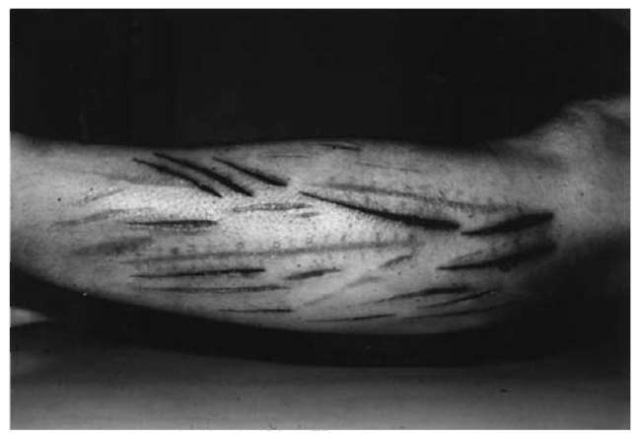
Figure 6 Left forearm of a 21-year-old depressive patient with a schizoid personality disorder and multiple episodes of self-cutting. Note the different wound age of scars and incisions.
If patients pretend to be unaware of the real origin of their skin artifacts, this phenomenon is called factitial dermatitis. The mysterious disease is intended to draw attention to the emotional suffering of the patient whose personality structure is characterized by strong intrapsychic tension, inhibited aggression, depressiveness, and low frustration tolerance. Psychological tests yield severe autoaggressive tendencies. The spectrum of skin lesions comprises scratches, ulcers, thermal and caustic burns (e.g. from cigarettes or acids) (Fig. 7), hematomas, and many others. Self-manipulation should always be considered when symptoms persist for a very long time in spite of adequate therapy.
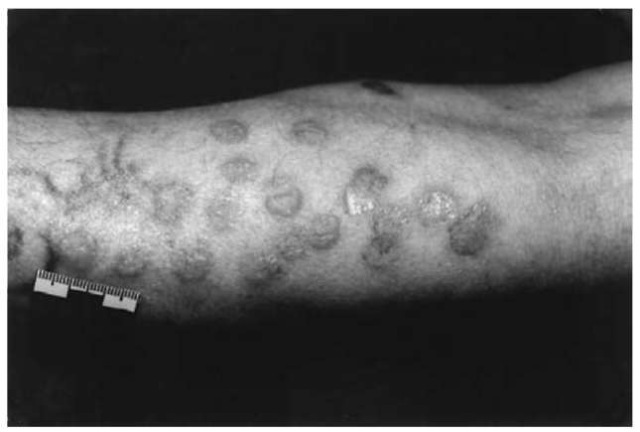
Figure 7 Multiple self-inflicted cigarette burns of equal age (1 day) on the left forearm of a 72-year-old psychiatric patient with paranoid ideas
Munchausen’s syndrome is defined as a chronic factitious disorder with systemic malingering observed in adult patients who present themselves to physicians and hospitals with dramatic, but false stories of illness. In assuming the role of physically ill patients, they submit to unnecessary medical procedures including invasive, painful and even dangerous treatment. The factitious diseases are made credible by complaining of symptoms such as abdominal pain, bleeding from body orifices, dermatological changes, and acute neurological manifestations. In contrast, Munchausen syndrome by proxy is a rare form of child abuse in which a parent or other carer, usually the mother, brings a child for medical assessment and care. The proxy either invents a false illness story or really induces an illness (e.g. by nonaccidental poisoning, smothering, or inflicting physical injuries on the child).
Some mentally retarded or disturbed children show special forms of self-destructive behavior such as lip biting, head bumping, and grinding of the teeth. Psychotic patients may be capable of mutilating themselves in a bizarre and painful manner so that the appearance of the injuries is often inconsistent with the outlined criteria of self-infliction. Thus, medico-legal literature reports on self-amputations (fingers, toes, scrotum, penis), but also on enucleation of an eye and severance of the tongue.
Attempted Suicide
An attempted suicide is an action performed with the stated intent of jeopardizing the person’s own life. An individual who in desperation gives the appearance of wishing to commit suicide, but lacks the real intention to do so, makes a ‘cry for help’ or a ‘suicidal gesture’. The methods of suicide attempts include the whole spectrum of intoxications and physical trauma: overdosed application of drugs, cutting and stabbing, jumping from heights or in front of a moving vehicle, gunshot injuries, electrocution, nonfatal asphyxia, burning, and jumping into water.
In the context of this article, only suicidal cutting and stabbing is discussed. Suicidal cuts are mostly inflicted by means of knives, razor blades, and other sharp-edged instruments. The flexor surfaces of the distal forearm, the cubital region, and the front of the neck are counted among the preferred ‘sites of election’. The presence of linear scars may suggest previous attempts. Suicidal incisions are typically multiple, parallel, superficial, and arranged in groups. The shallow cuts in particular reflect the hesitant or tentative nature of the injuries (Fig. 8).
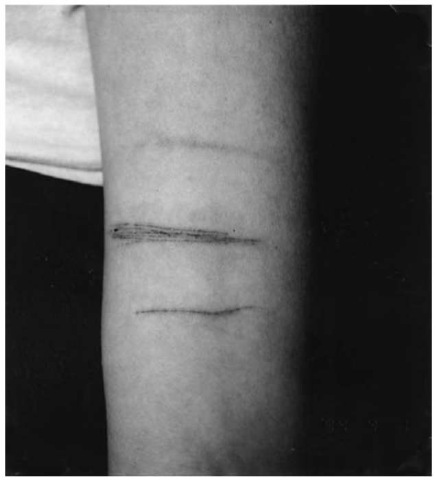
Figure 8 ‘Suicidal gesture’ of a young girl with several parallel, equally shallow, rather scratch-like cuts in the left cubital fossa.
In many suicide attempts the individual abandons the method of cutting the wrists and/or throat after a few trial incisions and turns to another kind of self-destruction which is expected to be more effective. In suicidal cuts of the wrists, the radial and ulnar arteries are severed only in rare cases. The left wrist is the most common target in right-handed persons, but about one half of suicides cut both the left and the right wrist. In suicidal throat cuts, the incisions either pass obliquely across the front of the neck (for instance starting high on the left and ending at a lower level on the right) or the direction is rather a horizontal one. Again, numerous tentative cuts are regarded as a clue to self-infliction.
Suicidal stabbing is less frequent than cutting and usually confined to the precordial region and/or the neck. In both locations the ‘classical’ pattern is characterized by grouped stabs without concomitant damage of the covering clothes. The wound slits in the skin are often parallel with the pointed end (produced by the cutting edge of the blade) always being on the same side. Similar to suicidal cuts, the existence of multiple trial stabs is accepted as a hallmark of self-infliction.
